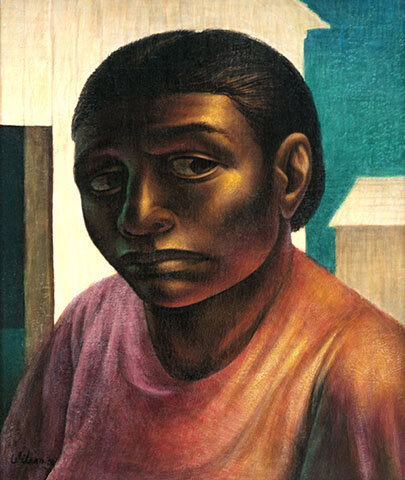January 17–May 10, 2020
Exhibition brings together nearly all of Wilson’s known preparatory works for his Mexico City mural from 1952
In 1952, while studying at La Esmeralda, the national school of art in Mexico City, African American artist John Wilson (1922–2015) painted The Incident, a fresco mural of a racial terror lynching at the hands of the Ku Klux Klan. Executed on an exterior wall at street level, the mural was intended to be temporary, but its commanding composition prompted renowned Mexican muralist David Alfaro Siqueiros—who was then the head of Mexico’s department for the protection and restoration of murals—to advocate for its preservation. Though the mural itself is no longer extant, Reckoning with “The Incident”: John Wilson’s Studies for a Lynching Mural brings together nearly all of the known preparatory sketches and painted studies for the fresco, as well as related drawings and prints, from the collections of the Faulconer Gallery, Grinnell College, Iowa, the Clark Atlanta University Art Museum, the Yale University Art Gallery, and select private lenders.
As a young man, Wilson was drawn to the work of Mexican muralists José Clemente Orozco, Diego Rivera, and Siqueiros and their commitment to create art with a socially conscious message. A grant from the John Hay Whitney Foundation allowed Wilson to travel to Mexico, where he studied from 1950 through 1956. He later commented, “The aim of the Mexican muralist movement was to be spokespeople for the common man. They wanted to create works of art expressing the reality of the forgotten ones, revealing their history, their celebrations and struggles….[Mural painting] is a public thing because it’s available to masses of people. And so, through Mexican art I began to experience a sense of how to depict my reality.” Of his choice of lynching as the subject matter for his Mexican mural, Wilson said that while he knew that he was not going to “change America,” it was an attempt to “exorcise” the feelings he had carried with him since seeing photographs of lynchings as a child.
Wilson explored the intersection of art and politics throughout his career, always with an eye toward issues of social justice. His most well-known work is a three-foot-tall bust of Dr. Martin Luther King, Jr., which has been on view in the Capitol Rotunda in Washington, D.C., since its 1986 installation. Reckoning with “The Incident”: John Wilson’s Studies for a Lynching Mural expands upon the national conversation focused in Montgomery, Alabama with the recent opening of the Equal Justice Initiative’s Legacy Museum and National Memorial for Peace and Justice—national monuments of unprecedented importance that honor and memorialize over 4,400 African Americans from 12 Southern states who were lynched between 1877 and 1950.
“Though no longer extant, John Wilson’s mural on the subject of a racial-terror lynching survives today in these numerous, beautifully articulated, and deeply emotive preparatory studies that attest to the transformative power of Wilson’s art,” states Elisabeth Hodermarsky, the Sutphin Family Curator of Prints and Drawings and cocurator of the exhibition. “Ranging from details in chalk of hands, feet, guns, and ropes to compositional cartoons in gouache, Wilson’s forcefully rendered studies help us contemplate the legacy of lynching and its indelible stain on America’s collective psyche.”
Stephanie Wiles, the Henry J. Heinz II Director, notes that, “Since 2008 the Gallery has enthusiastically explored opportunities for college and university museums to share collections and develop interdisciplinary programs that spark important conversations about art and its role in our lives.” Wiles continues, “Highlighting drawings, prints, and painted studies of John Wilson’s now-lost mural on the subject of a lynching, this exhibition provides an unparalleled opportunity to present the artist’s compelling contributions and unique visual response to racial violence and injustice to audiences across America.”
Please be advised that this exhibition includes images of a racial-terror lynching at the hands of the Ku Klux Klan that may elicit strong emotional responses. “Reckoning with ‘The Incident’: John Wilson’s Studies for a Lynching Mural” aims to stimulate thoughtful and respectful dialogue about the history and reality of racism and terror in this country.
On View
January 17–May 10, 2020
Yale University Art Gallery
Previous Venues
January 25–April 7, 2019
Faulconer Gallery, Grinnell College, Iowa
June 3–August 9, 2019
David C. Driskell Center, University of Maryland, College Park
October 6–December 6, 2019
Clark Atlanta University Art Museum
Exhibition Credits
Exhibition made possible by the Isabel B. Wilson Memorial Fund. Organized by Pamela Franks, Class of 1956 Director, Williams College Museum of Art, Williamstown, Mass., and former Senior Deputy Director and Seymour H. Knox, Jr., Curator of Modern and Contemporary Art, Yale University Art Gallery, and Elisabeth Hodermarsky, the Sutphin Family Curator of Prints and Drawings, Yale University Art Gallery.


